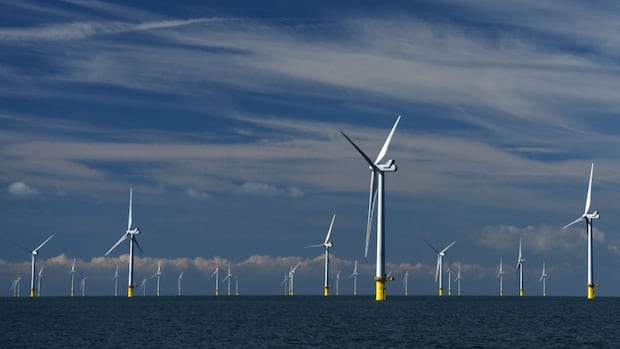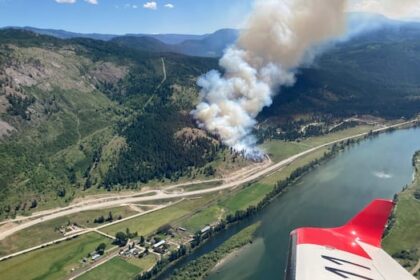Nova ScotiaPorts around Nova Scotia will have to undergo some big, costly upgrades to support the offshore wind build-out that politicians and energy companies are envisioning, according to the findings of a new study.Work could take years and hundreds of millions of dollarsTaryn Grant · CBC News · Posted: Sep 04, 2025 11:00 AM EDT | Last Updated: 4 hours agoWind turbines are seen off the coast of Sussex, England. Nova Scotia doesn’t currently have any offshore wind turbines, but the provincial and federal governments are setting the stage for private developers to build big in the next five years. (Mike Hewitt/Getty Images)Ports around Nova Scotia will have to undergo some big, costly upgrades to support the offshore wind industry build-out that politicians and energy companies are envisioning, according to the findings of a new study.Building longer and stronger wharfs, infilling and dredging the sea floor are among the items listed in a report released this week by Net Zero Atlantic, a non-profit renewable energy research group headquartered in Halifax.The study, led by the U.S.-based consultancy group Moffatt & Nichol, assessed 10 potential port locations in Atlantic Canada, including five in Nova Scotia. Some of the locations have well-established ports while others are currently vacant lots where port developments are in the planning.The report says the work that would enable the ports to handle the massive components and equipment for building and maintaining offshore wind farms would take anywhere from 21 months to more than nine years, depending on the port. Cost estimates for the Nova Scotia ports range from about $135 million to about $654 million. Read the full report Sven Scholtysik, the research director for Net Zero Atlantic, called the results encouraging.”The offshore wind industry is often constrained in other jurisdictions by the lack of available ports and the lack of available space to develop ports,” he said in an interview.”Atlantic Canada has really shown in this study that we have a lot of space and we have a lot of existing port size that can be ready for the offshore industry with a bit of additional investment.”WATCH | N.S. environment minister suggests offshore wind necessary to meet 2030 climate targets:Offshore wind could help N.S. reach climate goalsNova Scotia’s environment minister says the province’s goal of being off coal and generating 80 per cent of its electricity from renewables could require the help of offshore wind. As Michael Gorman reports, that creates a tricky situation for the government.Scholtysik said officials with all the shortlisted ports were engaged in the research and expressed interest in being part of the offshore wind industry.”They’re already investing in the port infrastructure … but there’s a lot of work to be done,” he said.Scale-up needed to meet Houston’s ‘Wind West’ visionThe report considers three possible scenarios for the build-out of offshore wind in Atlantic Canadian waters. In the “low” scenario there are 2.5 gigawatts of installed capacity, in the “medium” scenario there are 7.5 gigawatts and in the “high” scenario there are 11.5 gigawatts — all by 2050.Depending on the scenario, the report says Atlantic Canada would need one to three primary ports for supporting the construction of offshore wind farms, plus four to 12 ports to support operation and maintenance.All those scenarios fall far short of the vision that Nova Scotia Premier Tim Houston has been pitching recently, in which Nova Scotia alone would generate 40-plus gigawatts of energy from offshore wind in as little as a decade. Houston’s pitch, which he calls “Wind West,” includes the construction of transmission lines to export the electricity out of the province.Scholtysik said the port capacity study settled on its three scenarios before Houston started talking about Wind West. He said the scenarios could be scaled up to match a larger build-out of offshore turbines. It would simply require more ports and more investment, he said.’We need to get moving’Three companies that are hoping to build offshore wind projects in Nova Scotia waters also contributed to the study, including NovaEast Wind, which wants to deploy a flotilla of turbines on the French Bank with capacity for generating 300 to 400 megawatts.”We do need to get moving with port infrastructure and port upgrades in the near future,” said Gerry Sheehan, NovaEast’s project director, in an interview.”The port is one of the key pieces of infrastructure needed to actually build offshore wind.”Sheehan said the report’s timelines for building up port capacity, although lengthy, are workable for hitting NovaEast’s target of having turbines installed and operating by 2032 or 2033.He said he anticipates needing to use multiple ports, and that the upgrades may not need to be 100 per cent complete in order to accommodate the launch of NovaEast’s project.First, however, the company must secure a licence from the Canada-Nova Scotia Offshore Energy Regulator, which is supposed to open its first call for bids for offshore wind licences later this year.Sheehan said he expects offshore wind developers to pay for usage of the ports, but not for the upfront costs of building up their capacity.Scholtysik, of Net Zero Atlantic, said he expects a combination of public and private funding to cover the port upgrades, but ultimately, “it’s up to the ports to decide that.”ABOUT THE AUTHORTaryn Grant covers daily news for CBC Nova Scotia, with a particular interest in housing and homelessness, education, and health care. You can email her with tips and feedback at taryn.grant@cbc.ca
N.S. ports need major upgrades to support offshore wind industry, study finds










